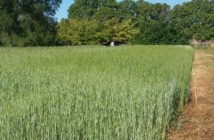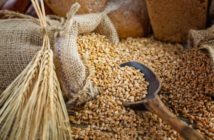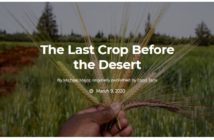NEW YORK TIMES
 Nati Harnik/Associated Press
Nati Harnik/Associated Press
Rows of corn stalks in a field south of Blair, Neb., this week. The drought-damaged field was cut down for silage.
By ANNIE LOWREY and RON NIXON
WASHINGTON — Scorching heat and the worst drought in nearly a half-century are threatening to send food prices up, spooking consumers and leading to worries about global food costs.
On Wednesday, the government said it expected the record-breaking weather to drive up the price for groceries next year, including milk, beef, chicken and pork. The drought is now affecting 88 percent of the corn crop, a staple of processed foods and animal feed as well as the nation’s leading farm export.
The government’s forecast, based on a consumer price index for food, estimated that prices would rise 4 to 5 percent for beef next year with slightly lower increases for pork, eggs and dairy products.
The drought comes along with heat. So far, 2012 is the hottest year ever recorded in the United States, according to the National Oceanic and Atmospheric Administration, whose records date to 1895. That has sapped the production of corn, soybeans and other crops, afflicting poultry and livestock in turn.
It is also harming parts of the infrastructure. Highways in Texas, nuclear power plants in Illinois, runways and subway rails in Washington and the concrete, steel and sophisticated engineering that undergird the nation’s infrastructure are being taxed to worrisome degrees by heat, drought and vicious storms.
The impact of the hot and dry weather on the nation’s farmers has put new pressure on Congress to move ahead on a pending five-year farm bill. But House Republican leaders have been reluctant to act because of divisions within the party’s rank-and-file about the cost of the nearly $1 trillion bill.
The legislation includes several federal agriculture programs that farmers have come to expect, though it does not include any specific drought assistance. Several important disaster relief programs expired at the end of 2011, leaving farmers and ranchers who have lost cattle or grazing land with few options without Congressional action.
“I’ve been urging the House of Representatives to get a bill to the floor and get it voted on so they can conference with the Senate and get a farm bill passed,” said Thomas J. Vilsack, the agriculture secretary.
For now, analysts said they expected the broader economic impact of rising food prices to be modest. Americans spend just 13 percent of their household budgets on food. The falling price of gasoline — fuel and transportation costs being a major component of prices at restaurants and grocery stores — will help temper any price increases.
Analysts said there might be little effect on economic growth or overall inflation, which has been running around 2 percent a year.
But economists said consumers — particularly the poor and unemployed — would still feel the effects.
“It is one extra kick in the stomach” for low-income families, said Chris G. Christopher, senior principal economist at IHS, a consulting firm. “There’s a lot of people in this country living paycheck to paycheck. This is not a good thing for them.”
Higher food prices might also damp consumer sentiment. “Consumers are very sensitive to the price of gas and food,” said Jeet Dutta, a senior economist at Moody’s Analytics. “But overall inflation will still look pretty moderate for the rest of the year.”
Economists fear a far greater impact outside of the United States because America is a major exporter of a broad variety of agricultural products. Lower production at home means less supply and higher prices abroad.
“We’re seeing the price of wheat, corn and beans go up,” said Marc Sadler, the head of the agricultural risk management team at the World Bank, noting that in other regions of the world, like Eastern Europe, yields were also falling.
“Food wheat is about bread and cookies and instant noodles. But it’s about instant noodles in Asia and Indonesia, as much as it is about what you’re going to buy in Walmart,” Mr. Sadler said.
Countries that import substantial amounts of animal feed made from corn and soybeans will feel the impact the most, said Maximo Torero, an economist with the International Food Policy Research Institute, an international research group.
On Wednesday, government data showed the extent to which the heat and the drought had devastated crops and provided a first look at next year’s expected price increases.
The Agriculture Department’s figures show the largest percentage increase next year in its price indexes is expected for beef, a rise of 4 to 5 percent. The price of dairy products will increase 3.5 to 4.5 percent and eggs by 3 to 4 percent. Pork is expected to rise 2.5 to 3.5 percent.
The department also slashed its estimate for what was supposed to be the largest corn harvest on record. The government cut its corn yield forecast to 146 bushels an acre for the year, the lowest corn yield since 2003. The outlook just last month was for 166 bushels. The soybean yield is projected to be 40 bushels an acre, down from an estimate of 43.9 last month.
Cattle farmers in several states have already started selling off or culling cattle because the drought has ruined grass for grazing and the price for corn for feed has skyrocketed.
Daniel R. Glickman, the agriculture secretary in the Clinton administration, said that as farmers started reducing or selling their herds, meat prices could fall because of a glut of beef on the market.
“So in the short term, that’s good for customers,” Mr. Glickman said.







